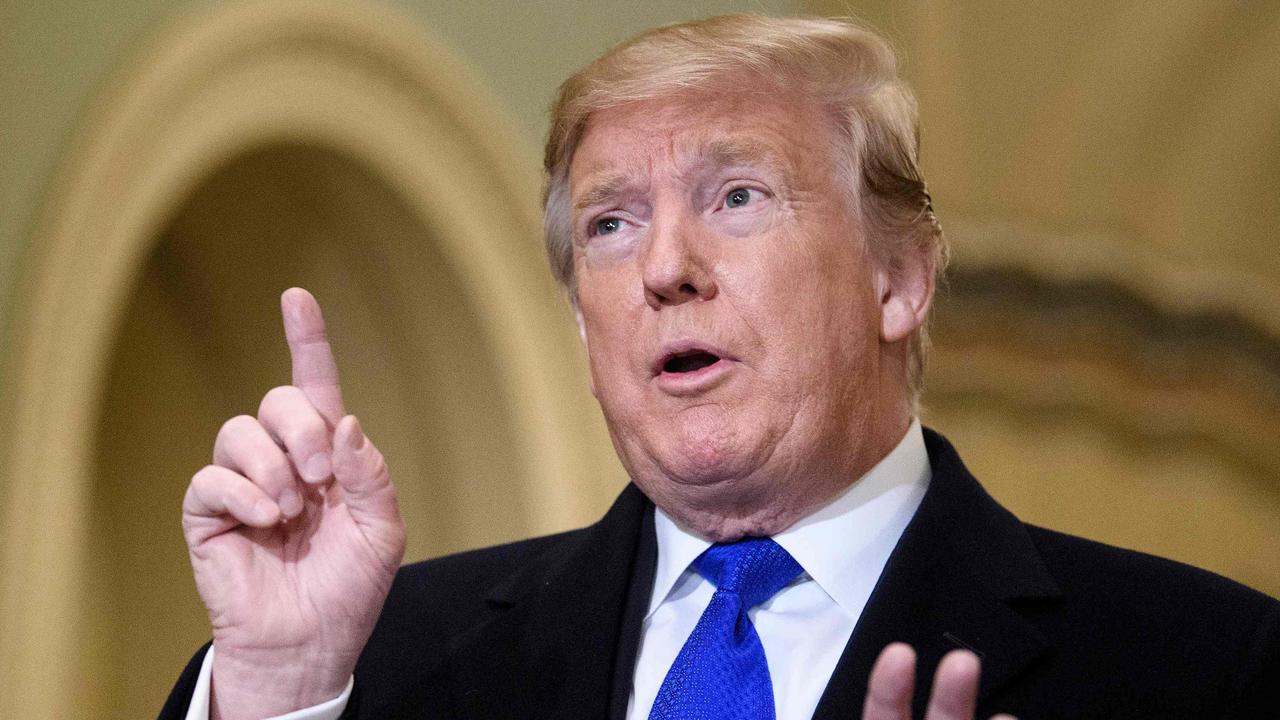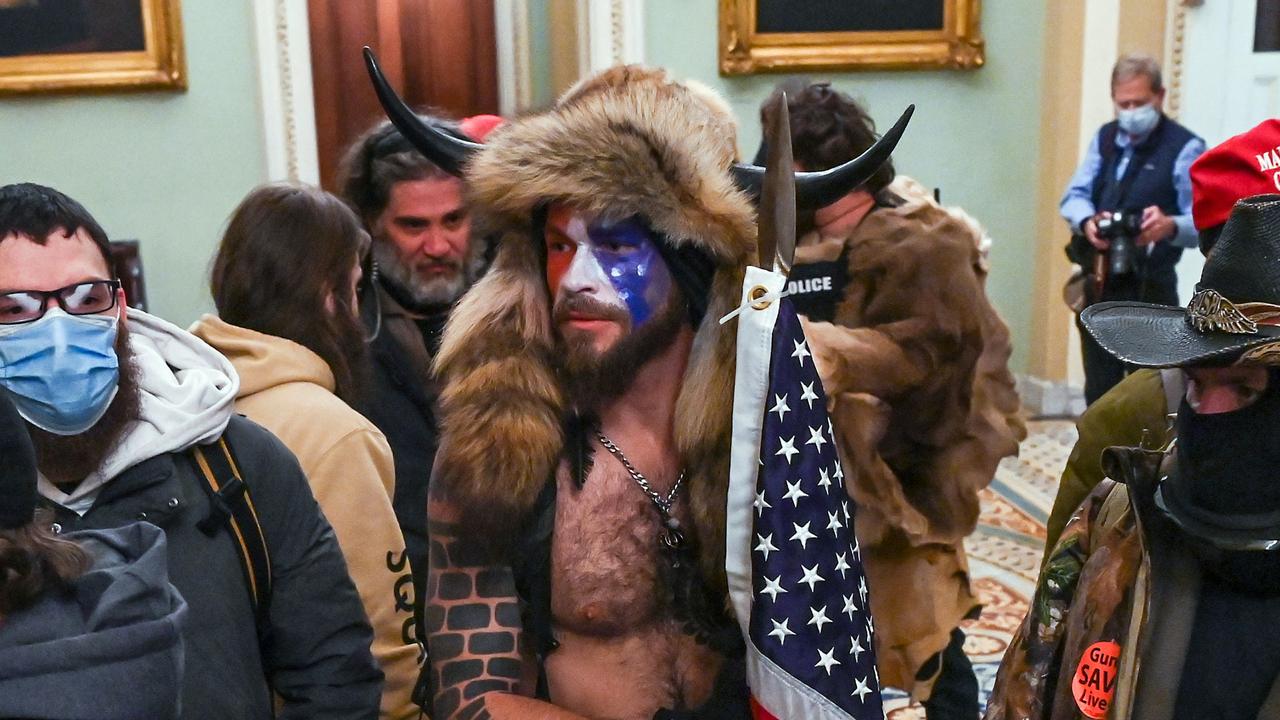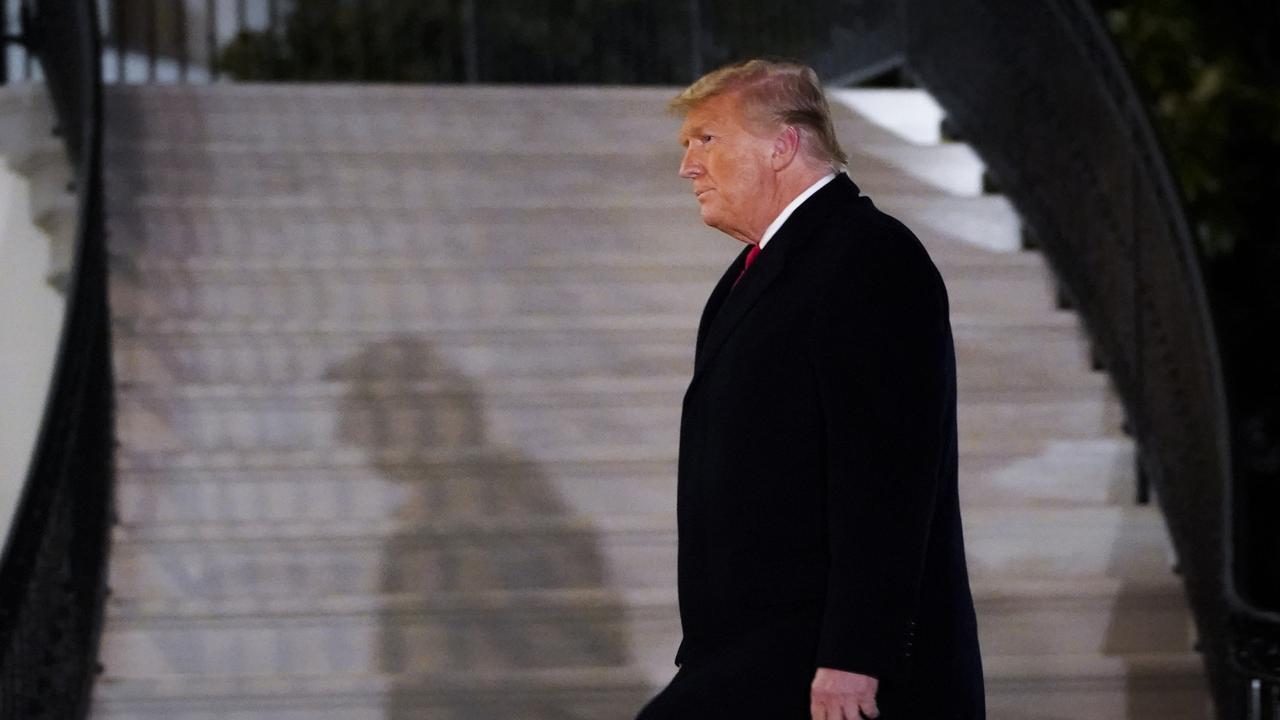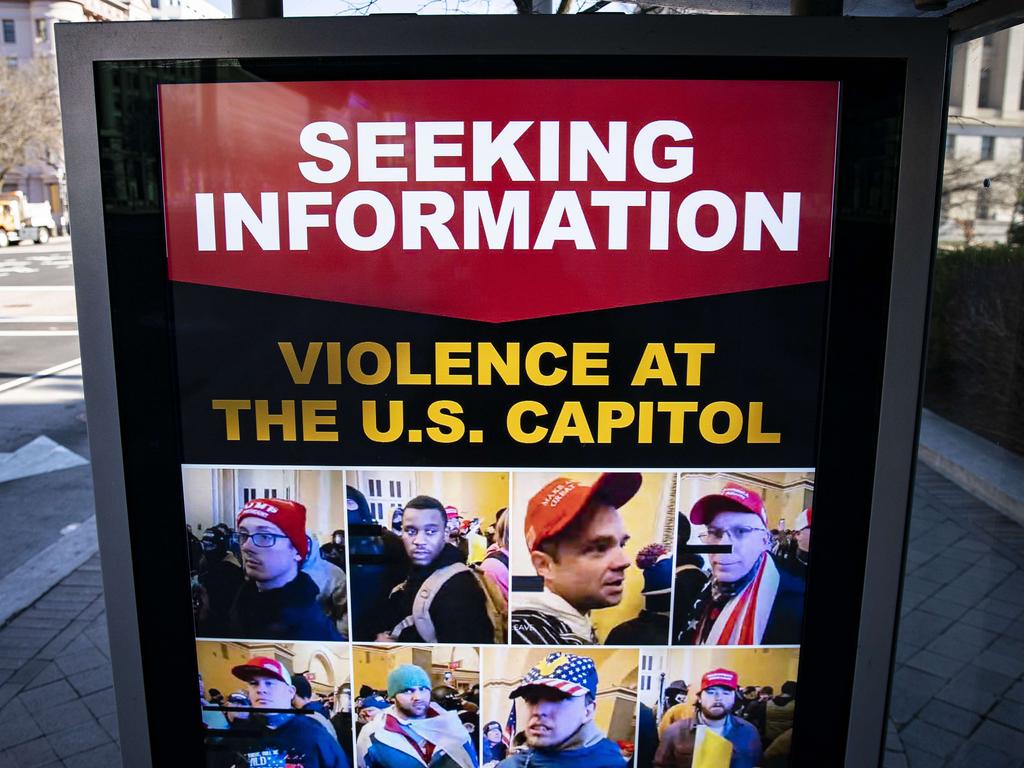Trump followers who stormed Capitol could have had a mass psychosis
They stormed en masse and caused chaos but there’s a very strange reason behind why thousands of people acted the way they did.
​Sticks and stones may break your bones … but words can incite you to use them.
The events at the US Capitol were shocking. But not unexpected. Especially to those who have been studying the psychology behind US President Donald Trump’s MAGA movement.
Leading a force of 100 militia to the US Capitol on January 6 was a serving US army psychological warfare officer.
Captain Emily Rainey is part of the 4th Psychological Operations Group based at strife-ridden Fort Bragg in North Carolina.
She has a specific job: “(To) use the power of influence to shape the global security environment and achieve United States national security goals.
She has a distinct skills set: “Specialise in unconventional capabilities, cultural expertise, language proficiency, military deception and advanced communications techniques encompassing all forms of media.”
Rainey says she was acting as an independent citizen during off-duty hours. But the weapons she wields were in full effect around her.
It was an unlikely convergence of dissimilar extremists sharing a common goal.
Nazis. Orthodox Jews. Evangelical Christians. Followers of the prophet QAnon. Republican MAGA enthusiasts.
RELATED: ‘Bombs, shooting’: US in on the brink

All had been convinced – against all evidence – that massive voter fraud had denied Mr Trump a second term in office. All had been incited to impose their delusions on their elected representatives in US Congress.
What resulted was an insurrection: “An organised attempt by a group of people to defeat their government and take control of their country, usually by violence.”
How did it come to this?
AMERICA, WHAT’S GOTTEN INTO YOU?
“Should lawmakers ever again be tempted to argue that social media platforms ought to be no-holds-barred free-speech zones, they would do well to recall the fear and the heartbreak of January 6: The day the internet came for them,” writes Wilson Centre disinformation expert Nina Jankowicz. “The effect of disinformation, conspiracy theories and extremism was on display for the entire world to see.”
It was a colourful sight.
Costumed followers of the internet “prophet” QAnon. Christian crusaders under a blood-red cross. Then there was the Nazi swastikas and white-supremacist symbology.
All proudly paraded on the steps of the US Capitol.
RELATED: ‘Death spiral’: USA’s horrifying new normal

It’s easy to dismiss those we disagree with as being ignorant fools.
Idiots. Jerks. Stupid. Crazy. Clowns. Buffoons.
However, such simplistic dismissive terms can conceal a raging “mind war” playing out in society around us. And such words can be applied to hide an insurrection in plain sight.
It’s a form of psychological warfare.
It’s about offering up an enticing way to make sense of the world. This sense can shape perceptions. It can induce behaviours. The trick is generating a sense that suits a strategic goal.
It can be economic marketing. It can be political motivation. It can be religious fervour. It can be propagandist manipulation.
Or it can be all of the above.
DOWN THE RABBIT HOLE
“I think it goes back to the basic way that our brain processes information. We can’t even look at clouds and pieces of toast without trying to connect the dots and see faces or elephants or pictures,” says University of Texas psychologist Professor Mary McNaughton-Cassill.
Brains also like stories. It gives context to details – thus reinforcing memory.
It’s why conspiracy myths are so enticing.
“Research shows that if you tell someone a story and you leave out a key component, like you don’t mention how they got across the river, later, people will fill in (their own) details,” the professor adds. “We’re looking for ways to try to make sense, and our brain will connect all sorts of things.”
But emotion also has a decisive role to play in delusion.
“Yes, there is great injury, anger and redirectable energy for hatred, which Trump harnessed and stoked for his manipulation and use,” says forensic psychiatrist Dr Bandy Lee. “The emotional bonds he has created facilitate shared psychosis at a massive scale.”

She told Scientific American that the appeal of militias and myths is a sign of deep turmoil within the United States.
Societal change. Income inequality. Disempowerment. This, she says, has produced an environment ripe for “narcissistic symbiosis”.
“The leader, hungry for adulation to compensate for an inner lack of self-worth, projects grandiose omnipotence – while the followers, rendered needy by societal stress or developmental injury, yearn for a parental figure,” says Dr Lee.
And Trump’s inner turmoil is contagious, she says.
“When a highly symptomatic individual is placed in an influential position, the person’s symptoms can spread through the population through emotional bonds, heightening existing pathologies and inducing delusions, paranoia and propensity for violence – even in previously healthy individuals.”
Such human frailties have been identified by marketers, lobbyists, political campaigners, propagandists – and psychological warfare officers – as useful tools. And social media has given them the means – for the first time – to manipulate masses in real-time.
MASS RADICALISATON
It was a tactic exploited by Islamic State (probably with a little covert help from Russia): To manipulate vulnerable, disaffected followers worldwide and incite them to violence.
It was called radicalisation.
Now, that same process is playing out across all levels of society.
“The conspiracy information ecosystem is highly international, and here in Australia conspiracy groups are often dominated by narratives and content emerging from the US,” warns Australian Strategic Policy Institute (ASPI) analyst Elise Thomas. “Ripples are already reaching Australia – and are likely to have implications for our own elections in 2022.”
The dividing lines between mainstream and fringe are shifting dramatically – even vanishing.
And there’s growing unanimity among analysts that profit-seeking social media algorithms are behind the deep penetration of distorted truth.

“Breaking through that echo chamber is critical or else we’ll see more violence,” warns former Department of Homeland Security extremist expert Elizabeth Neumann.
She says the threat of online extreme right-wing “rabbit holes of disinformation” keeps her up at night.
“How do I help people that have, unbeknown to them, become radicalised in their thought?” she asks. “They hold views they didn’t hold 10 years ago because all they listen to is that infotainment. Unless we help them break the deception, we cannot operate with 30 per cent of the country holding the extreme views that they do.”
THE SPIDER’S WEB
“The Capitol is our goal. Everything else is a distraction. Every corrupt member of Congress locked in one room and surrounded by real Americans is an opportunity that will never present itself again,” read a message posted to thedonald.win message board. “The final solution is the only solution.”
It was one social media post of millions.
Like the rest, its significance was overlooked – or ignored.
“Social media created this perfect storm,” Ms Jankowicz says. “Recommendation algorithms on platforms such as Facebook and YouTube prioritise engagement over truth, meaning that a search for natural health remedies, for instance, could lead users in only a few clicks to far more dangerous content.”
This, she says, explains how Capitol Hill’s “QAnon shaman” – adorned in furs, horns and Nordic tattoos – can be so obsessed with organic food.

“I monitored an ‘alternative health’ group on Facebook. Soon after I browsed through the group, Facebook suggested I join groups related to white supremacy,” Ms Jankowicz says.
Critics highlight how obscure recommendation algorithm systems (the AI selecting what posts or videos you see) will push viewers toward increasingly extreme content in a quest for clicks.
This presents an opportunity for search engine optimisation experts to “engineer attitudes”.
“The government and social media platforms have for too long refused to take seriously – or worse, embraced – this underbelly of the internet,” Ms Jankowicz says.
“Social media platforms aided and abetted their growth by driving vulnerable audiences to their content. And Republican officials, including Representative Paul Gosar of Arizona and Senator Ted Cruz of Texas, legitimised the theories rather than condemned them.”
MIND WARS
“We don’t trust the government. We don’t trust the Congress. We don’t trust the Supreme Court. We don’t trust science. We don’t trust medicine. We don’t trust the media for sure. So, who do we trust? Well, we trust our tribe. We trust conspiracy theories that tell us what we want to hear,” University of Maryland Professor Arie Kruglanski says.
Making matters worse is that people don’t like to change their minds.
Even less admit to themselves they were wrong.
It’s a fundamental problem for those combating radicalisation – be it political or religious, or both.
“People who harbour delusional narratives tend to bulldoze over reality in their attempt to deny that their own narrative is false,” Dr Lee says.

And that denial runs deep.
“Cult members and victims of abuse are often emotionally bonded to the relationship, unable to see the harm that is being done to them,” she says. “After a while, the magnitude of the deception conspires with their own psychological protections against pain and disappointment. This causes them to avoid seeing the truth.”
“Leadership matters,” says Kori Schake, a former senior adviser in the State Department, Defense Department and the National Security Council. “It really matters that the President of the United States is an arsonist of radicalisation. And it will really help when that is no longer the case.”
Dr Lee agrees. To a point.
“When the mind is hijacked for the benefit of the abuser, it becomes no longer a matter of presenting facts or appealing to logic,” she says. “Removing Trump from power and influence will be healing in itself.”
But it’s no magic bullet.
“The danger is that another pathological figure will come around and entice them with a false ‘solution’ that is really a harnessing of this resistance.”
COUNTER-ATTACK
“The events at the Capitol are still a loud wake-up call,” Ms Jankowicz says. “The United States has finally been shocked into understanding that the information people consume online has real-world consequences for public health, public safety and democracy.”
Exposure, Dr Lee says, is the key.
Confrontation isn’t helpful “for it will only rouse resistance,” she says.
“The problem with condemning conspiracy theories is that it plays into the conspiracy theorist’s mind,” adds Viren Swami, a social psychology professor at Anglia Ruskin University in the UK.

Persuasion won’t likely work either.
“The problem with conspiracy theories is if your basic premise is that everything you’re being told is false and there is a big secret event happening behind the scenes, then no matter what you’re told, you just assume that that’s propaganda,” Professor McNaughton-Cassill says.
The alternative is to enable believers to discover inherent contradictions for themselves.
Denied outside reinforcement, Dr Lee warns conspiracy adherents will suffer disillusionment, trauma – and anger.
“And this is all right – they are healthy reactions to an abnormal situation. We must provide emotional support for healing, and this includes societal support, such as sources of belonging and dignity.”
But the best defence says ASPI’s Elise Thomas is early – and honest – inoculation.
“It means speaking out swiftly, strongly and publicly against purveyors of conspiracy theories and disinformation about elections – regardless of who they are, or which party they belong to.”
IT’S NOT OVER YET
Fired chief of US cybersecurity Chris Krebs warns it will take years to undo the disinformation surrounding the Trump presidency.
“Over the next couple [of] years, we have to continue chipping away at the disinformation and the propaganda and the lies that have been spread over the last several years to generate and motivate and incite these actors,” he told US media this week. “The narrative’s been set; it’s been ingrained. I’m sure the President will continue to claim that the election was stolen, whether for fundraising opportunities or just to shield his ego.”
“We should consider the President, his followers and the nation as an ecology, not in isolation. Hence, what he does after this presidency depends a great deal on us,” Dr Lee says.
The worst possible outcome is for Trump to establish a “shadow” presidency.
“He will have no limit,” she says.

And new conspiracies are already being manipulated to divisive ends warns Ms Thomas.
“We should probably anticipate that the growing nexus between the fringe right-wing and fringe anti-Chinese Communist Party actors … will lead to particular individuals or groups being falsely accused of being agents of Chinese influence or somehow under the sway of the CCP, or that the election has been ‘hacked by China’,” she warns.
The consequences of such lies are real, including distracting security agencies from actual interference operations.
“You’d hope Australian politicians from all parties would not be so profoundly negligent, or prove to have such a weak commitment to democratic values and processes. However, there are some worrying signs,” Ms Thomas says.
Jamie Seidel is a freelance writer | @JamieSeidel




